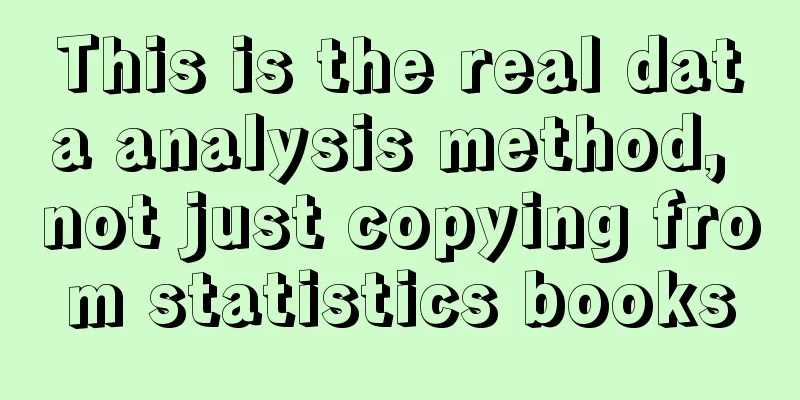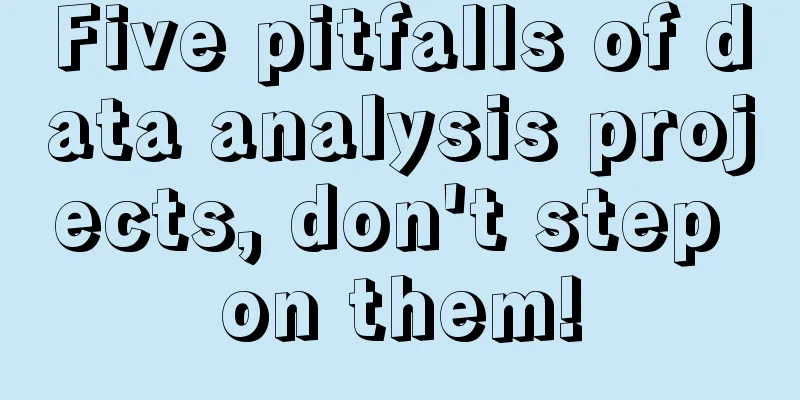This is the real data analysis method, not just copying from statistics books

Many students are confused: What exactly is a data analysis method? Because some of the descriptions of data analysis methods on the Internet are plagiarized from marketing books, such as 4Ps and PEST; some are plagiarized from statistics books, such as correlation analysis and regression analysis. But when it comes to doing the analysis, they are dumbfounded: Should we use P or regression to solve the problem at hand? If you want to truly understand and master data analysis methods, you can't just " find nails with a hammer ". Data analysis at work must be closely integrated with business and serve business needs. Therefore, only by understanding business needs and finding answers around problems can you understand the uses of various data analysis methods and how to use them. 1. Six typical business requirementsA complete business activity is divided into six steps: understand the current situation → set goals → make plans → monitor trends → diagnose problems → review results . At each stage, the information the business has and the problems it wants to solve are different, so the demand for data will be different (as shown in the figure below). If data analysts are involved in the work starting from the formulation of the annual business plan, they will go through all six steps. However, many students join the job midway through their career. The most common ones are: (1) Start with monitoring, output daily reports first, then find problems (2) Directly receive an analysis task and output a report on XX issue (3) The work has been completed, and a review report will be made afterwards At this point, it is very likely that the data analyst is not familiar with the business and is rushing to do something without any ideas. At this point, at least the first step, understanding the current state of the business, must be completed before taking appropriate measures. 2. Methods for understanding the current situationIn the stage of understanding the current situation, data indicators are presented systematically to let the business see the situation clearly. The data indicator system itself has three structures: parallel, process, and total score . Some common analysis methods correspond to these three forms. For example:
It should be noted that simply displaying indicators does not lead to any analytical conclusions. At least the indicators should be displayed + comparisons between different individuals should be conducted . for example: (1) DuPont analysis: comparing two companies in the same industry (2) UJM method: comparison of two different paths (3) RFM method: comparison between two user groups Therefore, when understanding the current situation, don’t just think about listing a bunch of indicators, but think about: who should be selected for comparison to better discover the differences between businesses and inspire the business department to think. 3. Methods of setting goalsDuring the goal setting phase, it is likely that the business will want to know: (1) If no changes are made, how will the business develop naturally? (2) How will the business develop if a certain resource investment is increased/decreased? (3) How will the business develop if a business practice is changed? This is where the problem of prediction comes in. To predict natural development trends, time series methods are generally used. Depending on the data trend, there are smoothing methods, autoregression, seasonal regression, regression with seasonal trends, and other methods available. If you consider changing resource inputs, you can consider regression with causality. Because there is generally a functional relationship between input and output, the input-output curve can be fitted through data to simulate the adjustment results. If you want to change your business practices, you must first check whether the business has taken similar measures. If there are similar practices, you can refer to the input-output situation of similar practices for calculation. If you have never done it, you must do a test first, otherwise you will just make a guess without data. It should be noted that when setting goals, it is often necessary to reflect the ideas of the leaders, and the data itself is only a reference. Therefore, it is very likely that after the natural situation forecast is completed, the business department will start to make decisions based on their own ideas. At this time, complex analysis methods may not be needed, but the data indicator system can be used to disassemble the KPI indicators, and then the relevant indicators can be increased or decreased according to the requirements of the leaders to simulate possible results. 4. Methods of making plansDuring the planning stage, the business may want to break down a big goal into specific execution tasks. At this time, the OGSM method can be used, which is a standard method for implementing qualitative goals into quantitative goals, breaking down quantitative goals into execution steps, and then monitoring execution (as shown below). It is also possible that the business does not want to dismantle it by itself first, but wants to see what the theoretical optimal solution is under the current input-output level. At this time, you can build an input-cost function and use cost-volume-profit analysis/linear programming methods to calculate the theoretical optimal solution for business reference (as shown below). Just like setting goals, when making plans, it is very likely that the business will rely entirely on experience, guess a number and start working. A plan that is too rough will lead to: unreasonable execution arrangements, temporary adjustments, and lack of backup plans, all of which will lead to problems in the execution process. If data analysts can understand the situation in advance, it will be much easier for them to monitor the trend in the next step. 5. Methods of monitoring trendsIn the trend monitoring stage, the core task is to observe whether the business is developing within expectations and whether there are abnormal fluctuations. Therefore, data analysis methods are needed to determine whether the business is normal. At this time, there are five methods available: cyclical analysis, input-output analysis, structural analysis, hierarchical analysis, and matrix analysis.
When monitoring trends, these conventional methods can be combined with monitoring indicators to form the same monitoring data dashboard. After observing abnormalities in the main indicators, you can directly view the data from the overall to the specific to see which part has a problem, thereby greatly improving the efficiency of discovering problems. 6. Problem Diagnosis MethodsIn the process of diagnosing a problem, whether there is a business hypothesis is the most critical. (1) If the business has nothing, then you can only build an analysis logic tree and troubleshoot the problem layer by layer. (2) If the business has a clear hypothesis, you can directly use the elimination method to verify whether the hypothesis is valid. (3) If the business already has a response plan, you can directly conduct experiments to test the feasibility of the plan Although when it comes to problem diagnosis, people will instinctively think of: building a logic tree. However, building a complete logic tree is too time-consuming and laborious, and many assumptions need to collect external data for verification. In real work, there is not always such sufficient data supply. Therefore, when diagnosing a problem, try to find business assumptions first and output conclusions quickly. When validating business hypotheses, whether or not to conduct experiments is the most critical difference: (1) If it is absolutely impossible to conduct experiments, then the only way to output analytical conclusions is through benchmark analysis (comparing good/bad individuals) and process diagnosis (analyzing the most lagging links in the business process). (2) If you can conduct an experiment but cannot do a sampling test, then you can only do a comparative analysis before and after the improvement. (3) If an experiment can be conducted and sampling tests can be performed, statistical methods can be used to test the experimental results. 7. Methods for reviewing resultsIf the first five steps are done well, it will be very easy to review the results: (1) Compare the goal and the actual gap and make a judgment: Is the performance good? (2) Retrieve process monitoring data to see if there are any problems during execution (3) Retrieve problem diagnosis data to see the cause of the problem and the results of the treatment Such a comprehensive review of the results is very comprehensive, including both the statement of results and the summary of experience. Many students find it very troublesome to review the process because they are not involved in the whole process and are only assigned the task of reviewing after the activity is over. At this time, they do not understand the goal and the process, so they have to review the process from beginning to end to get the result. If the business does not set clear goals and does not monitor the process data, they will be in the dark. Author: Down-to-earth Teacher Chen WeChat public account: Down-to-earth Teacher Chen (ID: gh_abf29df6ada8) |
<<: Make Tik Tok and create a persona that can be monetized!
Recommend
How to set up exclusive discounts for Amazon members? What are the discount rules for Amazon Prime members?
Amazon Prime membership program is one of the impo...
3 major paths, 7 ideas, this is how CNY marketing should be done!
This article organizes positive references for maj...
Chinese companies win the World Cup marketing war
The 2022 World Cup is over, Argentina won the cham...
What are the e-commerce platforms in Southeast Asia? Which ones are easy to operate?
In recent years, the cross-border e-commerce indus...
Is it difficult to pass the temu product selection? How does Temu select products?
Temu, as Pinduoduo's cross-border platform, ha...
How to do cross-border e-commerce? What are the tips?
When it comes to wish cross-border e-commerce, nov...
How Xiaohongshu leveraged TV drama topics to achieve a 300% increase in traffic
Xiaohongshu's efforts in seeding and marketing...
How does TikTok quickly locate traffic for product diagnosis?
As a TikTok merchant, do you want to know the stor...
Is Shopee cross-border e-commerce really profitable? Is there a fee for opening a store?
As an emerging business model, cross-border e-comm...
600,000 RMB for a video, post-00s internet celebrity "turns over", gains millions of fans but is exposed for not paying social security for employees
Internet celebrity "Wang Ma" Wang Zhixin...
Why do young people on Xiaohongshu and Douyin flock to ski resorts?
With the arrival of winter, skiing, once considere...
What are the Amazon FBM product selection techniques? How to do it well?
For Amazon merchants, after opening a store, they ...
WeChat has called itself “Subscription Account” for 12 years, and now all platforms have changed their names to “Public Account”
After 12 years of operation, the "Subscriptio...
How does AI empower the creation of high-quality live content?
This article deeply analyzes brand marketing strat...
Is Shopee profitable? How is the Shopee business?
For cross-border e-commerce, you can consider Shop...









